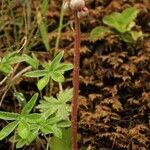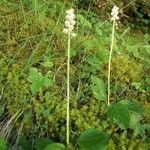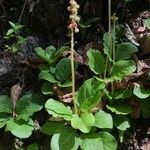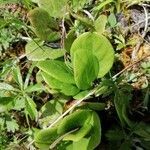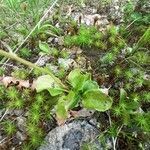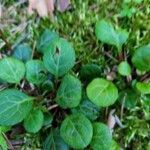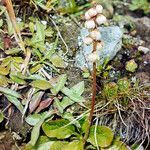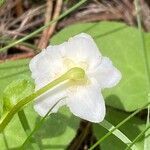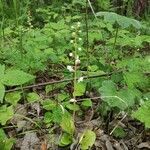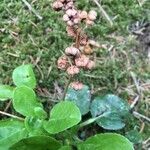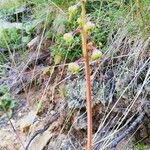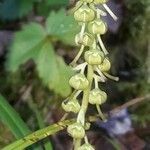Herbs (7–)12–20 cm tall. Rhizome creeping, long, somewhat slender, 0.5–1 mm in diam., branched, with sparse fine roots. Aerial stems ascending, short or somewhat long, 0.5–2.5 cm, not branched. Leaves appearing radical, 4–8, in 2 or 3 subverticils of 2–4 each; petiole 1–2.5 cm; leaf blade pale green abaxially, green adaxially, broadly elliptic to orbicular, 1.5–4.5 × 1.5–3 cm, base obtuse to truncate, margin crenulate to obsoletely serrulate, apex obtuse or mucronulate. Scape erect, 8–18 cm tall, angled, glabrous, with 3–5 broadly lanceolate-elliptic or broadly oblanceolate scales at base, up to 2 leafy scales or leaves near base, and up to 2 narrowly lanceolate to broadly linear scales near middle; raceme densely 7–16-flowered, 2–3.5 cm. Pedicel 3–6 mm; bracts broadly linear, 3–6 mm, usually longer than pedicel. Flowers drooping, regular, 6–7 mm in diam. Sepals depressed-deltoid or broadly ovate, 1–2 × 1–2 mm, apex obtuse to acuminate. Petals white, 3–6 mm, apex retuse. Filaments connivent, surrounding pistil, short, thick, glabrous; anthers yellow, 0.9–1.4 mm, without distinct tubules, apex truncate, opening by wide terminal pores. Style included, ca. 2 mm, straight or slightly curved, not dilated at apex into a ring; stigma with a collar and 5 radially arched lobes. Capsules 4–6 mm in diam. Fl. Jul, fr. Aug. 2n = 46.
Lvs elliptic or round-oblong, 2–4 cm, rounded to truncate at both ends; scape 5–15 cm, with a loose raceme of 5–15 nodding white fls; pet 5 mm; anthers very plump, 1 mm or less, broadly truncate to 2 wide terminal pores; style at anthesis ca 2 mm, about equaling the pet; 2n=46. Moist woods, circumboreal, in Amer. s. to the higher mts. of N. Engl. and n. Mich., and in the w. cordillera. (Braxilia m.; Erxlebenia m.)
A herb. It keeps growing from year to year and is evergreen. The rhizome or underground stem is slender and 0.5-1 mm thick. The leaf blade is green on top and pale green underneath. The flowers droop. There are 7-16 flowers in a group. The flowers are white. The fruit is a capsule which hangs down. It is 4-6 mm across. It has many very small seeds.
